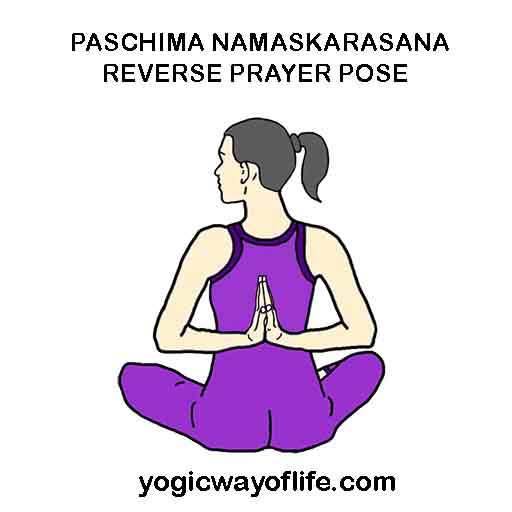Paschima Namaskarasana or the reverse prayer pose is also called the Viparita Namaskarasana. In Sanskrit, Paschima means west or in this context the back; Namaskara means Greetings and Asana means a Pose. This asana can be done in either the standing or the sitting posture. Paschima Namaskarasana is good for opening up the shoulder joints.
How to do Paschima Namaskarasana (Reverse Prayer Pose)?
- Sit in any comfortable posture like Sukhasana. This pose can also be done in Tadasana or the standing pose.
- Relax the shoulders and let the hands hang loosely by the sides.
- Take your hands behind your back very gently and let the hands meet.
- Now try to assume the Namaskara or prayer position behind your back. Both the palms touch each other.
- Try to raise the hands upwards and place it between the shoulder blades if possible.
- This is the final position. Breathe normally and stay in this position for as long as you are comfortable.
- To release the posture, separate the palms and bring down the hands to the side of the waist.
- You may rest a few minutes with palms placed on the thighs in the sitting position. If you feel any stiffness in the shoulders, you can gently rotate the shoulders in a circular motion forwards as well as backwards a few times. This can help to release any tension in the shoulder muscles.
- You can repeat this after taking break for a minute or so.
Benefits of Paschima Namaskarasana (Reverse Prayer Pose)
- Paschima Namaskarasana is very good for opening up the shoulder joints.
- It makes the shoulder muscles flexible.
- Flexing the shoulder muscles also stretches the muscles of the forearm up to the wrist. This is good for those who engage in typing in front of the computers for hours as this relaxes the muscles of the forearm, wrist, upper arm and the shoulders.
- It releases stress and calms down the mind.
- Paschima Namaskarasana opens the chest and improves breathing.
Contraindications for Paschima Namaskarasana
- Those suffering from any shoulder, neck or arm injury should avoid this pose.

